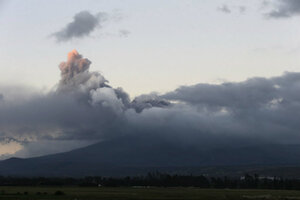Cotopaxi eruption: What's with all the volcanoes these days?
Volcanic activity in Cotopaxi, a volcano near the capital of Ecuador, is the latest incident in recent months, during which a number of volcanoes have come to life.

A view of Cotopaxi volcano spewing ashes as seen from Latacunga, Ecuador, Saturday, Aug. 15, 2015. The Cotopaxi volcano near Ecuador's capital has spewed ash over a wide area in pre-dawn blasts. The volcano is considered one of the world's most dangerous volcanoes due to a glacial cover that makes it prone to mud flows and its proximity to a heavily populated area, but government scientists say that the snow-capped volcano doesn't seem to be on the verge of a major eruption. Its last major eruption was in 1877.
Dolores Ochoa/AP Photo
Ecuador President Rafael Correa on Saturday declared a state of emergency following increased activity in the Cotopaxi volcano near the capital, Quito, the day before.
The decision, which comes in the wake of two minor explosions at Cotopaxi on Friday and led to a precautionary evacuation of small towns in the central part of the country, gives authorities greater flexibility to move government funds in the event of an eruption, Reuters reports.
“We declare a state of emergency due to the unusual activity of Mount Cotopaxi," President Correa said, according to the wire service. "God willing, everything will go well and the volcano will not erupt."
Cotopaxi is the latest to reflect a recent series of volcanic activity around the world, including ash emissions from Raung volcano in East Java, Indonesia which led to the closing of airports in Bali and shallow explosions at Sakurajima volcano in Kyushu, Japan. In 2014, volcanoes in Hawaii, Alaska, Italy, and Iceland, among other places, showed signs of activity.
What’s causing these volcanoes to come to life?
One cause could be shifts in the Earth’s rate of rotation. Since the late 19th century, relatively large changes in the velocity of the Earth’s spin tended to be followed by an increase in volcanic activity, a 2014 study published in the journal Terra Nova found.
As Robin Wylie, a postdoctoral researcher in volcanology at the University College of London, explained in The Conversation:
Altering the spin of a planet, even by a small amount, requires a huge amount of energy. It has been estimated that changes in the Earth’s rotation rate dissipate around 120,000 petajoules of energy each year – enough to power the United States for the same length of time. This energy is transferred into the Earth’s atmosphere and subsurface. And it is this second consequence that the Terra Nova authors believe could affect volcanoes.
Another cause, scientists say, is climate change. Over the last few years, “new evidence suggests that the volcano-climate relationship can go the other way, too: Periods of warming after ice ages can lead to volcanic eruptions,” according to Popular Science.
When glaciers melt as a result of rising temperatures, pressure on continents start to drop, while the rise in sea level increases pressures on portions of the Earth’s crust beneath the ocean, a 2012 study in the journal Geology found. The changing pressures could cause increases in volcanic activity, although it was unclear whether human-caused climate change could lead to the same impact, Marion Jegen, a geophysicist at Germany’s Helmholtz Centre for Ocean Research and co-author of the study told LiveScience.
A more recent study, conducted in geologically active Iceland, found that less pressure on the Earth’s surface could result in a “softer, more molten subsurface,” which makes it easier for magma chambers to reach the surface and lead to volcanic eruptions, Time reports.
“As the glaciers melt, the pressure on the underlying rocks decreases,” Kathleen Compton of the University of Arizona, a geoscientist and one of the paper’s co-authors, told the magazine. “Rocks at very high temperatures may stay in their solid phase if the pressure is high enough. As you reduce the pressure, you effectively lower the melting temperature.”
As yet, there’s no solid evidence connecting these findings and the volcanic activity occurring in the world today. Or as Dr. Wylie put it: “The link between climate change and volcanism is still poorly understood.”
Still, he continued, “this strange effect is a reminder that our planet can respond to change in unforeseen ways. Contrary to their brutish reputation, volcanoes are helping scientists understand just how sensitive our planet can be.”

